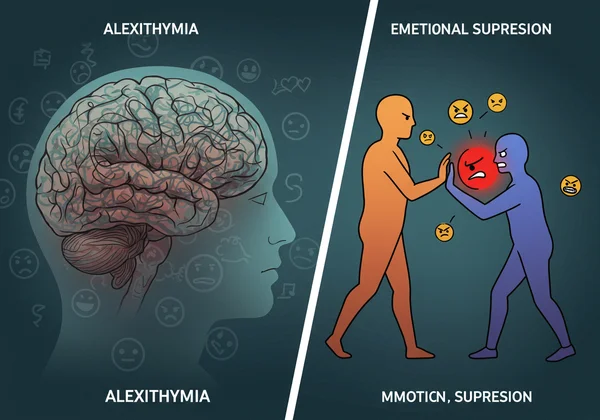Online Alexithymia Test: Symptoms & Emotional Blindness for Adults
Feeling disconnected from your emotions or struggling to express what you truly feel? You're not alone. Many people experience a trait known as alexithymia, sometimes called "emotional insight challenges." This guide will help you understand what is alexithymia, its common alexithymia symptoms, and how it differs from simply being emotionally numb. If you often find yourself wondering, "Why am I so bad at communicating my feelings?", exploring alexithymia might offer valuable insights into your inner world. Understanding these emotional patterns is the first step towards richer self-awareness. To begin your journey, you can explore your feelings with a simple assessment.
Understanding Alexithymia: More Than Just Emotional Blindness
Alexithymia isn't a mental disorder in itself, but rather a personality trait characterized by difficulties in identifying and describing one's own emotions and the emotions of others. It's not about being "cold" or "heartless," but about a specific challenge in emotional processing. For many, it's like their emotional landscape is a foreign language they struggle to interpret, leading to what some refer to as a lack of emotional perception. This trait can subtly influence daily life, from personal relationships to professional interactions.

The Core Definition: What Does Alexithymia Mean?
The term "alexithymia" originates from Greek, meaning "a lack of words for emotions." It was first described in the 1970s and is now recognized as a distinct construct in psychology. Individuals with alexithymia often have trouble distinguishing between bodily sensations linked to emotions (like a racing heart from anxiety) and physical symptoms (like a rapid heartbeat from exercise). This can make it incredibly challenging for them to pinpoint what they are feeling or even that they are feeling something. They might report feeling "fine" when, in fact, they are experiencing significant distress, simply lacking the internal language to articulate it.
Primary vs. Secondary Alexithymia: Different Origins
While the experience of alexithymia might feel similar across individuals, its origins can vary. Psychologists often distinguish between two main types:
- Primary Alexithymia: This type is thought to be a stable personality trait, possibly linked to neurobiological factors or early developmental experiences. It means the individual has consistently struggled with emotional awareness throughout their life.
- Secondary Alexithymia: This form develops as a response to specific life events or conditions, such as severe trauma, chronic stress, or certain mental health disorders like depression or anxiety. In these cases, alexithymia might be a coping mechanism or a temporary state, potentially diminishing as the underlying issues are addressed. Understanding the difference can be crucial for finding appropriate support and pathways for emotional growth.
Recognizing the Signs: Common Alexithymia Symptoms
Recognizing the alexithymia symptoms can be the first step towards gaining clarity, whether for yourself or someone you care about. These signs of alexithymia manifest in various ways, impacting internal experience and external interactions. Many adults, including those with neurodevelopmental differences, find our alexithymia test for adults helpful for an initial look into these traits.
Difficulty Identifying Feelings: "What Am I Feeling?"
One of the hallmark alexithymia symptoms is the profound difficulty identifying feelings. Imagine a situation where most people would feel joy, sadness, or anger. Someone with alexithymia might simply experience a vague sense of discomfort or arousal, without being able to label the specific emotion. They might not know if their stomach ache is anxiety or hunger, or if their quickened pulse is excitement or fear. This internal confusion about "what am I feeling?" can be deeply disorienting and make it hard to understand their own reactions or motivations. For instance, someone might feel intense physical tension before a presentation, but simply label it 'nerves,' unable to pinpoint the underlying anxiety or excitement.

Challenges Describing Emotions: Putting Feelings into Words
Beyond recognizing emotions, individuals with alexithymia often face challenges describing emotions. Even if they sense something, finding the words to articulate it to others or even to themselves feels impossible. This can lead to frustration in relationships, as partners or friends might perceive them as distant or uncommunicative. They might resort to describing physical sensations ("my chest feels tight") rather than emotional states ("I'm anxious") or speak in very concrete, factual terms about situations rather than their emotional impact. This difficulty with putting feelings into words often leaves others asking, "Are you emotionally unavailable?" Consider someone trying to comfort a grieving friend; they might want to express sympathy but only manage a factual comment about the situation, not knowing how to articulate shared sorrow.
Limited Imagination & Fantasies: Impact on Inner Life
Another less commonly known but significant trait is limited imagination & fantasies. People with alexithymia often report a reduced capacity for fantasy, dreaming, or engaging in imaginative play. Their thought processes tend to be more concrete, factual, and focused on external realities rather than internal experiences or abstract concepts. This can impact creativity, empathy, and the ability to engage in self-reflection in a nuanced way, potentially leading to a more structured and less spontaneous inner life.
Concrete Thinking & Social Difficulties
The tendency towards concrete thinking is closely linked to social difficulties. Because emotions are often abstract and nuanced, a literal thinking style can hinder understanding social cues, non-verbal communication, and the subtle emotional currents in interactions. This can make it challenging to empathize with others, interpret their intentions, or navigate complex social situations, leading to misunderstandings or perceived social awkwardness. Building and maintaining deep relationships can become a significant hurdle when one struggles to process emotional information effectively.
Alexithymia vs. Emotional Numbness: Key Distinctions
It's easy to confuse alexithymia with emotional numbness or apathy, but there are crucial differences. While both might involve a perceived lack of emotional experience, the underlying mechanisms are distinct. Understanding this distinction is vital for accurate self-assessment and for finding appropriate strategies. If you're exploring these differences, an online alexithymia test can provide useful clarity.
When Emotions Are Present But Unrecognized
The core difference lies in whether emotions are truly absent or simply not consciously accessible. In alexithymia, emotions are often present but unrecognized. The individual might still experience physiological arousal (like a racing heart or tense muscles) in emotionally charged situations, but they cannot consciously link these sensations to a specific emotion like fear or excitement. It’s not that they don’t have feelings; it’s that they lack the cognitive and linguistic tools to process and articulate them. This can be profoundly isolating, as the person senses something but cannot grasp what.
Understanding Emotional Suppression vs. Lack of Awareness
Emotional suppression is a conscious effort to push feelings away, ignore them, or hide them from others. This is often a coping mechanism, where emotions are felt but intentionally managed or hidden. In contrast, alexithymia involves a fundamental lack of awareness and understanding of emotions. There's no deliberate suppression because the individual isn't consciously aware of the emotion to begin with. Someone might suppress anger, knowing they feel it but choosing not to show it. Someone with alexithymia might not even register that they are angry, perhaps only feeling a vague irritation or physical tension. This distinction highlights that alexithymia is less about choosing not to feel and more about a difficulty in the process of feeling.

Taking the First Step: Explore Your Emotional World
Now that you understand what is alexithymia and its symptoms, let's explore how you can take the next steps to engage with your emotional world. It's important to remember that alexithymia is a trait, not a flaw. Recognizing these patterns can open doors to new strategies for understanding yourself and improving your interactions with others. Whether you're a self-explorer like Jordan, or someone seeking to better articulate your feelings in therapy like Chris, this knowledge empowers you to seek tailored support.
If this article resonates with your experiences, or if you're curious to learn more about your own emotional processing style, our platform offers a reliable, science-backed online alexithymia test. Our platform provides a simple, confidential way to get a preliminary understanding of your traits. You can receive an instant summary score, or opt for our unique AI Personalized Report, which offers in-depth insights and actionable advice based on concepts from scales like the OAQG2. This AI report can illuminate personal strengths, challenges, and practical steps for navigating your emotional landscape. Ready to begin your exploration? Take the free alexithymia test and embark on a journey to make exploration easier and life richer.

Frequently Asked Questions About Alexithymia
How do you tell if you have alexithymia?
Recognizing alexithymia often begins with noticing consistent difficulties in identifying and expressing emotions. Signs of alexithymia include struggling to put feelings into words, not being able to distinguish between physical sensations and emotional states, having limited imagination, and sometimes appearing indifferent to others' feelings. If these descriptions sound familiar, a self-assessment tool like the alexithymia test available here can provide an initial indication of alexithymic traits. This test is designed to help you explore your emotional patterns.
Can you self-diagnose alexithymia?
No, you cannot self-diagnose alexithymia in a clinical sense. Alexithymia is a complex psychological construct, and professional diagnosis requires a comprehensive evaluation by a qualified mental health professional, such as a psychologist or psychiatrist. Online tests, including the alexithymia test online offered on this site, are excellent screening tools for self-exploration and awareness. They can help you understand if you exhibit significant alexithymic traits, but they are not substitutes for a formal diagnosis or professional medical advice. Always consult with a professional for any health concerns.
What is the root cause of alexithymia?
The root cause of alexithymia is not fully understood, and it's likely multifactorial. Research suggests a combination of genetic predispositions, neurobiological factors (differences in brain structures or functions related to emotion processing), and environmental influences. Early childhood experiences, such as developmental trauma or adverse relational environments where emotional expression was discouraged, may also contribute to the development of secondary alexithymia. It's seen as a trait that can develop from various pathways, affecting how individuals process and understand their feelings.
Is alexithymia a trauma response?
Alexithymia can be a trauma response, particularly secondary alexithymia. When individuals experience significant or prolonged trauma, their brains and bodies may adapt by numbing emotional experiences as a coping mechanism to survive overwhelming distress. This can lead to a reduced capacity to identify, process, and express emotions, resembling alexithymia. While not all cases of alexithymia are linked to trauma, it is a significant contributing factor for many, especially those who develop the trait later in life following traumatic events. Understanding this link is crucial for therapeutic approaches aiming to help individuals reconnect with their emotions.